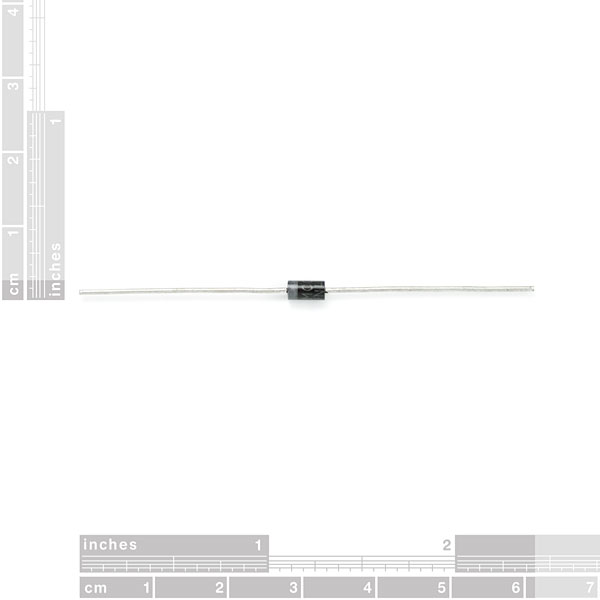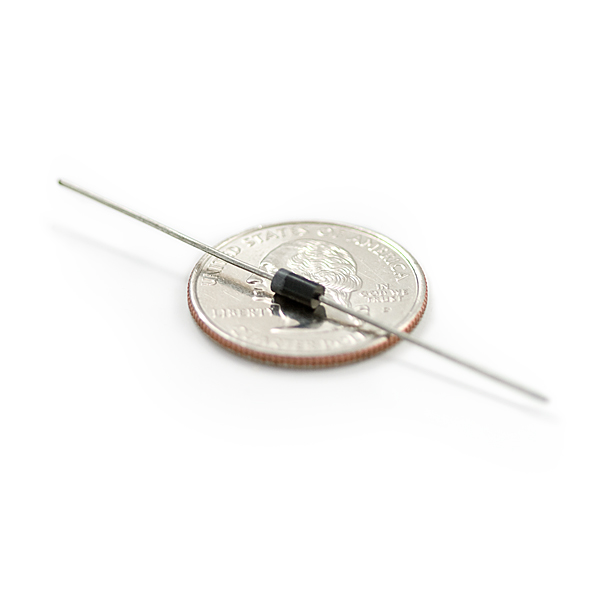Diode Rectifier - 1A, 50V (1N4001)
This is a simple, subminiature size, axial lead mounted rectifier diode. Often used for reverse voltage protection, the 1N4001 is a staple for many power, DC to DC step up, and breadboard projects. The 1N4001 is rated for up to 1A/50V.
Diode Rectifier - 1A, 50V (1N4001) Product Help and Resources
Beginner Parts Kit Identification Guide
March 22, 2019
The essential parts for beginning (or even experienced) hobbyists that gives you all of the basic through-hole components you will need to get started playing with embedded projects. We'll identify a few parts in the kit and provide a few basic circuits to get started!
Flyback Diodes
These are good for flyback diodes on things like relays and solenoids. Here’s a good tutorial that explains how this works. They keep you from killing your transistor or MOSFET. http://www.douglaskrantz.com/Flyback_Diode.html
Wikipedia has a more technical description here => https://en.wikipedia.org/wiki/Flyback_diode .
Core Skill: Soldering
This skill defines how difficult the soldering is on a particular product. It might be a couple simple solder joints, or require special reflow tools.
Skill Level: Noob - Some basic soldering is required, but it is limited to a just a few pins, basic through-hole soldering, and couple (if any) polarized components. A basic soldering iron is all you should need.
See all skill levels
Core Skill: Electrical Prototyping
If it requires power, you need to know how much, what all the pins do, and how to hook it up. You may need to reference datasheets, schematics, and know the ins and outs of electronics.
Skill Level: Competent - You will be required to reference a datasheet or schematic to know how to use a component. Your knowledge of a datasheet will only require basic features like power requirements, pinouts, or communications type. Also, you may need a power supply that?s greater than 12V or more than 1A worth of current.
See all skill levels
Comments
Looking for answers to technical questions?
We welcome your comments and suggestions below. However, if you are looking for solutions to technical questions please see our Technical Assistance page.
Customer Reviews
5 out of 5
Based on 1 ratings:
1 of 1 found this helpful:
Great
Nothing really to say. Works like a charm!




Still will be nice to see small rectifier diode definition in the description sector.
Switching speed??
I often wonder why anyone buys 1N4001's anymore. Buying in bulk, you can get 1N4001's for $0.09 each. 1N4007's with the same current rating but a 1000V breakdown are $0.11 each.
Because they're 2 cents (18%) cheaper? Assuming 50V suffices.
Stupid question: If it can handle 1A at 50 V, will it be able to take a greater amperage at a lower voltage (say, 2A at 12V)?
(edit: fixed typo)
No, it is not a power or watt rating, but 2 separate ratings. Voltage and amperage. The amperage limitation is typically heat based, where the voltage is a "breakdown voltage" - This is the point where the normally non-conductive material the diode is made of becomes conductive.
More specifically, the 1A is the forward biased current rating, and the 50V is reverse bias breakdown voltage.
Or less.
Digikey lists them at exactly the same price for most of the manufacturers. Prices/100:
Diodes, Inc: $8.50/$8.50
Micro Commer: $8.50/$8.50
Fairchild: $9.00/$9.70
ON: $10.96/$10.96
Vishay: $13.39/$13.39
I thought the capacitance ratings might be different, but the datasheets say no.
Uhh, I'm not seeing any though hole 1N4007s on Digikey that a cheaper than $0.11 (that you can buy in quantities as low as 100). There are several that you can get 1000/~$80 ... but that's a bit much for me. ;)
Edit: Ahh, I misspoke. When you buy that one in a package of 100, it becomes $0.0649/part -- or $6.49/100. Nice.
I always wasn't sure how this diode is working. To all of you that are still unsure here is good explanation about rectifier diode.
Anybody know what the voltage drop across this might be? About .7v?
At 1A more like 1V, which people often ignore, having the 0.7V stuck in their minds. The datasheet should give you a V-A graph.
I've been following this tutorial (http://www.youtube.com/watch?v=2q59Kqw4gaM&feature=plcp) for using relays with a microcontroller, and it mentions using a diode to prevent the microcontroller from getting fried. Will this diode work for that purpose?